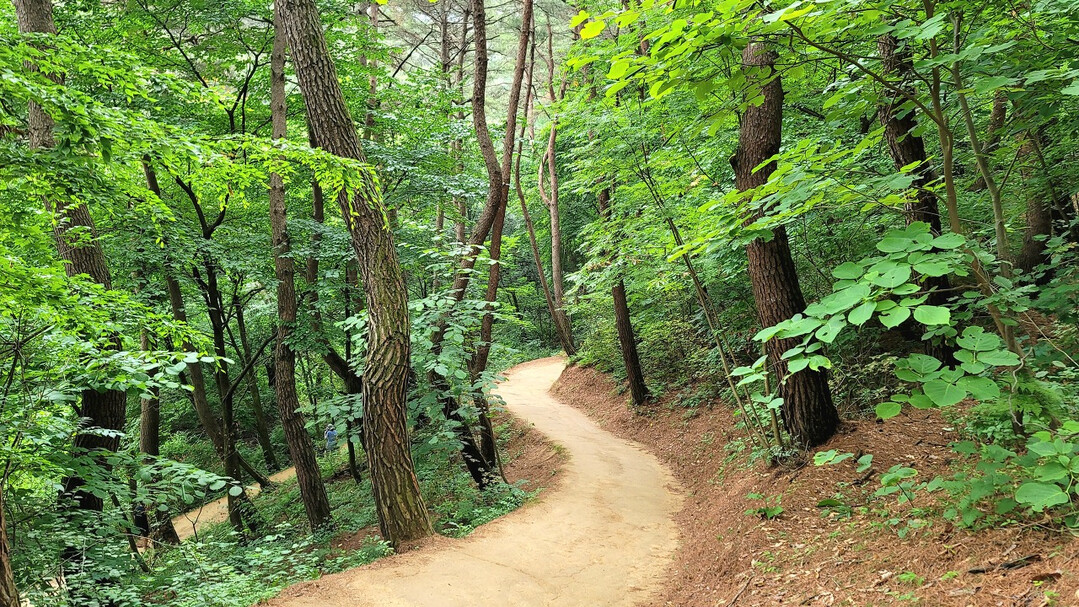
Wonju, Gangwon Province – After five years of dedicated effort, the city of Wonju proudly announced the full opening of the Chiaksan National Park Perimeter Trail on April 20th. This extensive network comprises 11 distinct courses stretching a total of 140 kilometers, offering an unprecedented opportunity to experience the hitherto concealed beauty of the renowned yet rugged Chiaksan. Following the initial opening of the first three courses in 2019, the newly unveiled 4th to 11th courses promise to reveal the park's most breathtaking and previously inaccessible landscapes. This reporter recently embarked on a journey through the newly accessible 8th to 11th courses, personally witnessing the remarkable scenery and captivating allure that Chiaksan harbors.
Spanning not only Wonju but also parts of Yeongwol and Hoengseong counties, the 140-kilometer Chiaksan Perimeter Trail stands in contrast to the Jirisan Perimeter Trail by intentionally traversing both inside and outside the boundaries of Chiaksan National Park. This unique design allows hikers to appreciate not only the majestic mountain terrain but also the serene rural villages and the modern cityscape of the Innovation City, providing a diverse and engaging trekking experience. The city of Wonju spearheaded the trail's development, with collaborative efforts from Hoengseong and Yeongwol counties ensuring its completion.
8th Course, "Geobukbau (Turtle Rock) Trail": From Historic Church to Turtle-Shaped Rock
The 8th course, aptly named "Geobukbau Trail," commences at the historic Yongsomak Catholic Church, a 117-year-old landmark designated as a Gangwon Province Cultural Heritage site. This venerable church holds significant historical importance for the Korean Catholic Church and houses a museum dedicated to Father Seon Jong-wan, renowned for his dedication to Bible translation. Departing from the church and heading west towards Guhaksan Mountain (elevation 983m), the trail passes the tranquil Korean Temple before reaching the expansive Guhaksan Observatory. While the path leading to the observatory has undergone thinning to enhance visibility, resulting in more direct sunlight, the panoramic view from the top encompasses the entire Shinlim-myeon area and the magnificent Birobong Peak of Chiaksan Mountain.
While developing the trail along the slopes of Guhaksan, Wonju City officials discovered a massive rock formation resembling a turtle, leading to the naming of the course as "Geobukbau Trail." Utilizing a portion of the existing Guhaksan Forest Trail, the route has been enhanced with newly constructed sections to bypass inconvenient areas, ensuring a more pleasant experience for visitors.
9th Course, "Jajaknamu (Birch Tree) Trail": Refreshing Strolls Through Birch Forests
The 9th course, the "Jajaknamu Trail," stretches a considerable 15 kilometers. However, the captivating birch tree forests lining both sides of the path make the distance feel remarkably shorter. Starting at the Shinlim-myeon Seokdongjongjeom Bus Stop and heading towards Gumidong before turning onto Yeogol Road, hikers encounter a refreshing landscape of birch trees, planted during past logging road construction. Though not densely packed, the swaying birch leaves create a soothing rustling sound, seemingly purifying the very air around those who walk beneath them.
Along the way, the trail passes the Chiaksan Natural Recreation Forest, established in 1994. Recently, five of its forest cabins have been renovated, offering visitors a more comfortable stay. An overnight stay at the recreation forest combined with trekking the perimeter trail promises an unparalleled forest healing experience. After passing the recreation forest and reaching the Baramgol Peak, a steep downhill section leads to Geumdae Samgeori. For safer trekking, Wonju City recommends traversing the 9th course in a counter-clockwise direction.
10th Course, "Aheunahopgol (Ninety-Nine Valleys) Trail" & 11th Course, "Hangateo Trail": Hidden Gems of Primeval Forests and Valleys
The 10th course, the "Aheunahopgol Trail," begins at Geumdae Tourist Area and unfolds along the pristine Wonju Stream. Thanks to the clean natural environment near the national park, picturesque rural houses dot the surrounding landscape. Crossing the Gomnemi Bridge leads into the forest, marking the entrance to the 본격적인 Aheunahopgol, or Ninety-Nine Valleys. Numerous valleys, including Dwindolgol, Tapgol, and Ilonggol, weave through the area, each carrying intriguing legends. One such tale recounts a bear hunter who fled in astonishment after witnessing 99 bears traversing the 99 valleys. The dense larch forests within Aheunahopgol hint at the breathtaking autumn foliage to come.
The 11th course, the "Hangateo Trail," located near the Wonju Innovation City, has garnered significant popularity even before its official opening. Passing the now-closed Bangok Station (which ceased operations in January) and ascending towards Hangateo Samgeori, hikers encounter a lush Korean pine forest. Jeon Chan-bong, the official in charge of tourism development in Wonju City, recounted his surprise at discovering the beautiful pine grove in a seemingly untouched part of the forest during the trail survey. Beyond the pine forest, the path towards Gukhyeongsa Temple meanders through dense primeval forests and moss-covered valleys, presenting a mystical landscape akin to Chiaksan's hidden "secret forest."
The Chiaksan Perimeter Trail offers a welcoming alternative for those who may have felt daunted by the challenging ascent to the main peaks. The 140 kilometers of diverse trails promise an unforgettable communion with nature, poised to establish itself as a premier tourist destination in Wonju.
[Copyright (c) Global Economic Times. All Rights Reserved.]



























